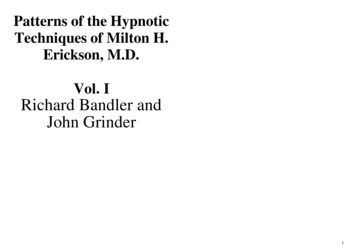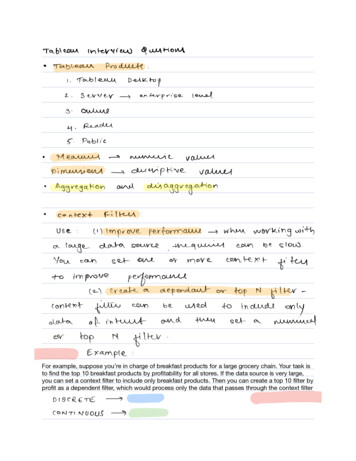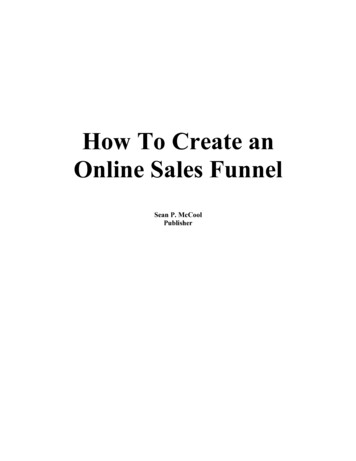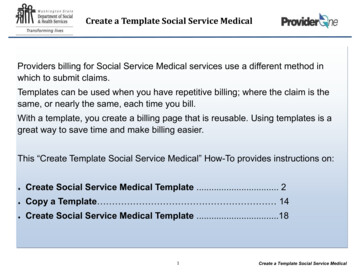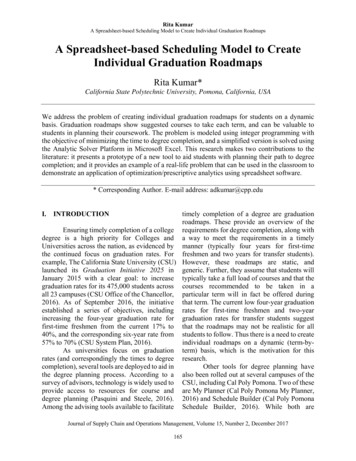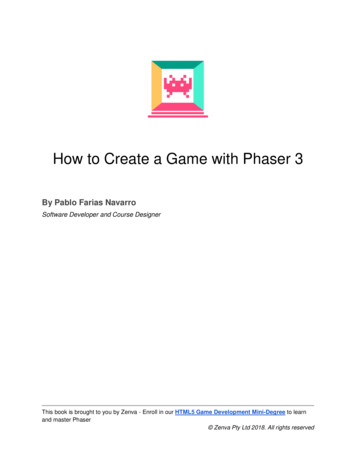
Transcription
CREATE A HYPNOTIC FLOWHow toCreate aHypnotic FlowHennekeDuistermaat1
CREATE A HYPNOTIC FLOWThis is a free chapter from the book Blog to Win Business“This IS the business blogger's survival guide. Keep this ammoon your bookshelf if ever you find yourself in a lurch.” Sean Work, Director of Inbound Marketing, KISSmetricsFor more information about the book, go usiness/2
CREATE A HYPNOTIC FLOWCreate a flow tohypnotize your readersEver read about the breadmaker techniquefor blogging?The idea is that you follow a known recipeto half-automate your process.Baking bread in a breadmaker is supereasy. Add the ingredients to the bread panin the right order, press a few buttons, andvoilà: 5 hours later your bread is ready.Create a natural flow thatkeeps your reader spellboundSure, it’s not artisan bread, but it’s tastyand free from enhancers and additives.Plus, if you use the timer, the lovely smellof fresh bread wafts up to your bedroomearly in the morning, welcoming the newday, and teasing you to get up.Using blog post recipes is a bit like bakingbread in a breadmaker. You follow a proven process with known ingredients. Youcompose an attention-grabbing headline. You write an opening that makes yourreader crave more. You write bite-sized sentences and an inspirational paragraphfor dessert.And you create an effortless flow. This free guide discusses: Whether you should outline your posts or not How to use proven blog post recipes to create a logical flow The ideal blog post lengthNote: This guide refers to several blog posts and explains how they’re structured.You get most out of this chapter if you’re able to read the blog posts while goingthrough this chapter.Ready?Let’s start.3
CREATE A HYPNOTIC FLOWTo outline or not to outlineOutlining a post means planning what you’re going to write and in which orderyou’re going to write it. Some blogging experts may say that you should outlineall your blog posts, but outlining has both advantages and disadvantages.Outlining can help you create a logical flow in your blog posts. Outlining canspeed up your writing process because you’re less likely to veer off track intoareas that are irrelevant to your post. In other words, when you don’t outline apost, you probably cross out more irrelevant paragraphs and spend more timeediting to ensure each paragraph logically follows the paragraph above it. Attimes you may even struggle to arrange your paragraphs, as your key point hasbeen buried somewhere half way in your post.When outlining a post, however, you have to do all the thinking up front. Youtake away the opportunity to come up with new ideas while writing becauseyou’ve already laid down a blueprint to follow. Writing becomes more of amechanical routine rather than a creative process. Of course, writing doesn’talways have to be a creative process. Following the steps you’ve outlined is agood way to write blog posts.My advice is to experiment with different processes and see what works for you.You may find that you use outlines for certain post types while freewritingothers. That’s how it works for me.To help you with outlining your posts, you'll find recipes for 3 popular post typesbelow. The blog post topics I refer to below are all about writing or contentmarketing. However, you can use these “recipes” to write a blog post about anytopic.Proven recipe #1: The long-list postLong-list posts take some time to compile, but they’re worth your effort.Numbers stand out in social media streams, and posts with high numbers tend toget shared more often. Long-list posts also provide an excellent opportunity toshow off your in-depth knowledge about a topic.For long-list posts, I always create an outline. Otherwise I risk creating a list ofrandom tips without any order or logic. You need to break your topic down inlogical parts so you can give your reader time to breathe again. This is what youdo when outlining your post.I’ve written a guest post summarizing the best advice on writing marketing4
CREATE A HYPNOTIC FLOWemails—it became the most shared post on Copyblogger in 2013. You can checkout the post here: /I created four different sections for this post. This is the outline:Provisional headline: How to write emailsIntro: Readers might struggle to get their emails don’t get opened, but thispost helps to write emails that get opened, read, and clickedPart 1: Why and how to make your emails conversationalPart 2: How to get emails openedPart 3: How to get emails readPart 4: How to sell in your emailsConclusion: Never take anyone’s attention for grantedThe introduction of this blog post opens up a gap between the current situationfor many readers (struggling to get emails opened) and the desired destination(getting emails opened, read, and clicked).The advice is broken down in 4 different parts—each part includes 8 to 11 tips. Along-list post is a checklist written in an engaging way—often with links toarticles that explain tips in more detail.Each section is introduced by a subhead to tempt readers to continue. Thesubheads are simplified versions of headlines: How to create emails that areeagerly anticipated, How to get your emails opened, How to write engagingemails, and How to sell in your emails.Reading a long list of tips can become monotonous. To give readers breathingspace, each section features a mini-introduction reminding the reader that theauthor feels their pain or reminding them of the promise that they’ll learn how togain readers and clients by writing better emails. The mini-introductions addressthe reader directly using the word you.As always, avoid common-sense advice in your post. When readers get thefeeling that you’re including many tips they already know, they quickly switchoff. Make every tip valuable and don’t waste your readers’ time. This is also agood opportunity to practice writing sound bites as each tip should be short andcontain a nugget of wisdom.A long-list post is overwhelming, as nobody can implement so many tips in onego. The conclusion should, therefore, remind people of one key point or a firststep they should take. The final paragraphs of this blog post reminds people ofthe idea behind the blog post: treat your readers like friends, and don’t takeanyone’s attention for granted.5
CREATE A HYPNOTIC FLOWProven recipe #2: The short-list postAs a general guide, long-lists posts have at least 20 different tips, but usuallymore than 30. Short lists posts can have as few as 5 tips.Each article you publish should have one big idea. Each argument, each story,and each example should support this big idea. Even a list post centers aroundone idea. In the example above, the big idea is that people should treat theiremail subscribers as friends—even if they want to sell to them.Below follows the outline I wrote for a short-list post with blogging stakes/). In my email to theCopyblogger editor, I explained my “big idea:” Many people are jumping on theblogging bandwagon without thinking what they can do for their readers. Theyend up taking up space rather than adding value.Here’s the outline I wrote in the same email:Provisional headline: 11 Ways You’re Wasting Your Blog Readers' Time1. You don’t care about your topic2. You don’t write in plain English3. You love complexity4. You’re self-indulgent5. You think you need to publish daily6. You write purely for SEO7. You focus on word count8. Your conclusions are stale9. You don’t know who you’re writing for10. You don’t edit11. You don't show your personalityTips in a long-list post are conveyed in one or two sentences. In a short-list post,a tip may cover one paragraph or a few paragraphs—this depends on the numberof tips and the length of the post. Try to be consistent in the number ofparagraphs you use for each tip.Follow these key requirements to make a short-list post a success: Remember to create enticing subheads.Describe each tip in a few short paragraphs.Don’t stick to a rigid format for each tip, as you become predictable andstart boring your readers. Do try to be consistent in the overall length ofeach tip.Introduce variation by starting some tips with a question and other tips6
CREATE A HYPNOTIC FLOW with an ultra-short sentence.Include bullet points when appropriate, but not for each tip.If your list is a series of mistakes, give people suggestions of how to do it right.Otherwise you just make them feel miserable or foolish about their mistakes. Alist with mistakes requires an upbeat final paragraph.Proven recipe #3: The how-to postA how-to post is similar to a short list of tips, but the tips follow a strict order: dothis first, then this, and then that. The steps can be numbered, but that’s notrequired.The KISSmetrics post How to Use the Persuasive Power of Mini-Stories in YourSales Copy /] is based on the“big idea” that sales copy often turns people off while stories mesmerize. Thepost provides a guide to using stories to make sales copy engaging andpersuasive.As this concept of story-telling is rather fuzzy, and because it may be difficult tounderstand how it works in practice, the post features various examples, plus alarge part of the article is used to persuade readers that mini-stories arebeneficial.Here's the outline:Headline: How to Use the Persuasive Power of Mini-Stories in Your SalesCopyIntro: Sales copy is often a turn off, but you can write sales copy asmesmerizing as storiesBenefit 1: Increase desire to buyBenefit 2: Persuade by creating a sensory experienceBenefit 3: Make a boring product fascinatingBenefit 4: Strengthen a brand by adding personalityGuide: How to write your own mini-storiesConclusion: Reinforce the points that boring companies don’t exist andthat each company has stories to tellA standard how-to post will feature a list of steps and, possibly, examples of eachstep. But if you suspect your ideal reader doesn’t get the concept or doesn’tunderstand its benefits, you need to spend more time explaining the why ratherthan the how.This how-to post spends a lot of energy on the why. The opening paragraph7
CREATE A HYPNOTIC FLOWhighlights the difference between stories and sales copy, and the science behindthe persuasiveness of stories. A quote of an expert is used to increase thecredibility 0f this argument. Using expert quotes is a useful way to make yourarguments more credible and authoritative. By dropping quotes into your blogposts from time to time, you also show that you know what others in yourindustry are saying.The why of story-telling is explained with 4 benefits. Each section about abenefit follows a similar outline: Short introExampleExplanation of the exampleHow to apply this to your own story-tellingAfter the 4 benefits of story-telling are explained, the post summarizes the howto in the section Three Principles for Writing Seductive Mini-Stories.A how-to post doesn’t always have to follow this exact outline. Many how-toposts simply illustrate the various steps you need to take to gain a certain result—whether it’s learning how to handle a difficult boss, how to repair a puncture, orhow to draw a stick-figure.How-to posts are popular. Best-selling author Jonah Berger suggests in his bookContagious that people love sharing practical information.How to improve the flow of your postsWhen you next write a blog post, create a working title first, then pick a “recipe”you feel is most suitable for your post. Are you sharing a selection of tips? Howmany? Pick the short-list recipe if you decide to go for fewer than 20 or so tips.Go for a long-list post when you have more tips.Are you sharing a guide or a loose selection of tips? If you’re sharing a step-bystep guide, go for the how-to post. Remember: you don’t need to follow thisguide to the letter. If the why is less important, you can limit it to one section. Ifthe how is more complicated, then spend more sections on the steps yourreaders should follow. Add examples to make your advice less abstract andclarify your points.This is how I move from “recipe” to a fully written post: Create a working title—this should include a specific benefit because that’s8
CREATE A HYPNOTIC FLOW what guides you in outlining and writing the postWrite down what your reader is most struggling with and what the desiredresult is—this is the information you can use later for your introductionOutline each section of your main body—the main body excludes yourintroductory and final paragraphsWrite a first draft of your main bodyLeave your first draft to simmer overnight and edit it the next dayDecide which obstacle prevents your ideal reader from implementing youradvice, address this obstacle in your conclusion, and write your conclusionwhen you feel freshReread your post to ensure you’ve kept to the promise you outlined in theheadlineWrite the opening paragraph as you outlined or update it if you’ve changedyour mind—keep your ideal reader in mind when writingRework your headline—write at least a dozen different versions beforedeciding on your favoriteRead your blog post aloud to ensure it sounds conversational—we discussediting in more detail in the next chapterThis is the process that works for me. I don’t like writing a blog opening first, asit adds pressure to the writing process because I know my opening and closinglines need to be the best I can come up with. I find it easier to do this once I’m inthe flow of writing.You don’t need to stick to my process (of course!)—find what works for you. Also,don’t limit yourself to the recipes described in this chapter. When you read awell-structured post, you can dissect it and find the building blocks—just like I’vedone with the recipes and examples here.But don’t feel you need to look for other recipes. The vast majority of my postsfollow the 3 recipes outlined above.How long should
speed up your writing process because you’re less likely to veer off track into areas that are irrelevant to your post. In other words, when you don’t outline a post, you probably cross out more irrelevant paragraphs and spend more time editing to ensure each paragraph logically follows the paragraph above it. At times you may even struggle to arrange your paragraphs, as your key point has .
